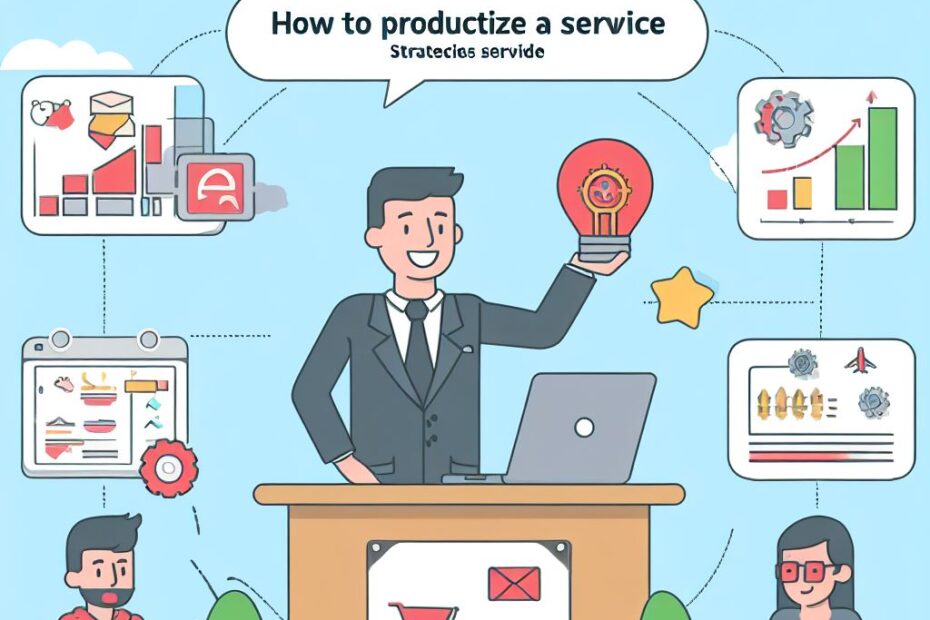In this article, we will explore effective strategies and best practices how to productize a service. In today’s business landscape, many service-based businesses are exploring the concept of productizing their offerings. Productizing a service involves transforming your service into a structured, scalable, and easily replicable product. This approach allows businesses to enhance value, create new revenue streams, and improve customer satisfaction.
Understand Your Service and Customers
Before diving into the exciting journey of productization, it is crucial to invest time and effort in gaining a comprehensive understanding of your service and your target customers. By conducting thorough research, actively seeking feedback, and analyzing customer pain points, you can effectively identify the most valuable aspects of your service that have the potential to be transformed into successful products.
To begin, start by conducting meticulous market research. This involves analyzing industry trends, studying competitors, and identifying gaps or opportunities within the market. By doing so, you can gain valuable insights into the needs and expectations of customers, enabling you to refine and tailor your service offerings accordingly.
Additionally, collect and analyze feedback from your existing customers. This can be done through surveys, interviews, or even social media interactions. By actively listening to your customers’ opinions and experiences, you can uncover valuable information about what aspects of your service resonate the most with them and what pain points they wish to be addressed.
Furthermore, pinpointing customer pain points and challenges is crucial in the quest for productization. By identifying recurring issues or challenges faced by your target customers, you can create product features or solutions that specifically address those pain points. This customer-centric approach not only enhances the value proposition of your offering but also increases the likelihood of product success and customer satisfaction.
A solid foundation of understanding your service and customers lays the groundwork for successful productization. Through comprehensive market research, active customer feedback collection, and analyzing pain points, you can uncover invaluable insights that guide your productization journey. Remember, customer-centricity is key, as it enables you to transform the most valuable aspects of your service into innovative, customer-driven products.
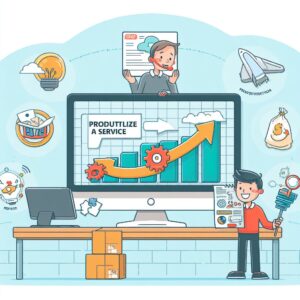
Define a Clear Value Proposition
In the pursuit of productization success, it is crucial to define a concise and persuasive value proposition that effectively communicates the distinct advantages and benefits of your transformed service. By clearly articulating how your offering solves customers’ problems, saves time, or enhances outcomes, you can not only attract but also retain valuable customers.
Crafting a captivating value proposition begins with understanding the pain points and needs of your target customer base. Analyze the challenges they face and identify how your productized service provides a solution to address those specific issues. Consider the unique features, functionality, or approach that sets your offering apart from competitors, and emphasize these differentiators in your value proposition.
To create an impact, ensure that your value proposition conveys the value in a simple and concise manner. Avoid using technical jargon or complex language that might confuse or alienate potential customers. Instead, focus on using clear and compelling language that resonates with your audience and clearly communicates how your productized service can make their lives better.
Highlight the tangible benefits that customers can expect from your offering. Whether it’s time-saving, cost-efficiency, improved productivity, or enhanced outcomes, make sure to explicitly mention these advantages in your value proposition. This allows potential customers to quickly grasp the unique value your productized service brings and motivates them to engage with your offering.
Finally, remember that a compelling value proposition isn’t a one-time effort. It should be regularly reviewed, refined, and aligned with evolving customer needs and market trends. Conduct market research, gather customer feedback, and adapt your value proposition accordingly to ensure its continued relevance and effectiveness.
A well-defined and persuasive value proposition is an integral part of attracting and retaining customers for your productized service. By clearly communicating the unique benefits, solutions, and advantages your offering brings, you can create a compelling case for customers to choose your product. Continuously refine and adapt your value proposition to stay relevant and in tune with customer expectations, ultimately fostering strong customer engagement and loyalty.
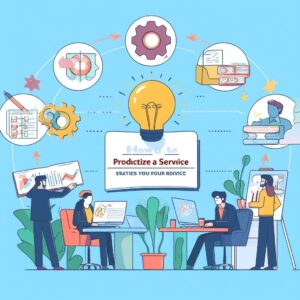
Decompose and Reconfigure
To achieve operational excellence and improve the scalability of your service, it is essential to break down its various elements into core components, processes, or modules that can be standardized and packaged as a product. By doing so, you can identify repetitive tasks or deliverables and streamline them to enhance efficiency and maintain consistency.
Start by conducting a comprehensive analysis of your service and identify its distinct components. Look for patterns and repetitions in your workflow, tasks, or outcomes. By recognizing these repetitive elements, you can begin the process of systematizing and standardizing them.
Once you have identified the repetitive tasks or deliverables, analyze them closely to find ways to streamline their execution. This can involve optimizing processes, automating certain steps, or creating templates and frameworks that facilitate consistency and efficiency. By creating a systematic approach, you can ensure that these tasks are executed in a predictable and reliable manner, reducing the margin for error and improving overall efficiency.
As you decompose and reconfigure your service, don’t forget to keep customer satisfaction at the forefront. The aim is not just to standardize and streamline internal processes but also to deliver consistent value and quality to customers. Ensure that the core components and modules align with customer expectations and provide a seamless experience.
Continuously evaluate and refine your standardized components to adapt to evolving customer needs and market trends. Embrace feedback from customers and team members to identify areas for improvement and innovation. This iterative approach will allow you to stay agile and responsive to changes in the industry while maintaining high levels of efficiency and consistency.
By decomposing your service into standardized components and streamlining repetitive tasks, you can achieve greater efficiency and consistency. This process allows for the systematization of workflows, leading to improved scalability and customer satisfaction. By continuously evaluating and refining your standardized components, you can adapt to changing market demands and ensure long-term success.

Pricing and Packaging
Create a strategic pricing model that reflects the value of your productized service, taking into account various factors such as service complexity, market demand, and competition. Introduce diverse packages or tiers to cater to a wide range of customer needs and budgets.
One of the crucial aspects of effectively monetizing your productized service is to develop a pricing model that accurately aligns with the value it delivers. Start by thoroughly assessing the complexity of your service and its unique selling propositions. Consider the benefits, outcomes, and impact your service provides to customers. This analysis will help you determine the optimal price range that reflects the value clients obtain from engaging with your offerings.
In addition to evaluating the intrinsic value of your service, take into account market demand and competitive pricing strategies. Research competitors in your industry and review the pricing structures they have in place. This information will help you gauge the market’s expectations and adjust your pricing accordingly while maintaining your competitive edge.
To cater to a diverse customer base, consider implementing different packaging options or tiers. By offering multiple tiers, you can provide customers with a choice that suits their specific needs and budget constraints. Segmentation can be based on service features, levels of support, or scalability options. Clearly communicate the attributes and benefits of each package to guide customers in selecting the most suitable option.
It’s essential to regularly review and refine your pricing strategy. Monitor customer feedback, market trends, and the evolving landscape to ensure your pricing remains competitive and aligns with the perceived value. Consider conducting market research or surveys to gauge customer satisfaction and willingness to pay.
Remember, pricing is an integral element of your overall value proposition. Striking the right balance between affordability and the value delivered will not only attract customers but also ensure the sustainability and profitability of your productized service.
Developing a well-thought-out pricing model and packaging strategy is essential to maximize revenue generation and address a diverse customer base. By aligning pricing with value, understanding market dynamics, and offering flexible packaging options, you can optimize customer satisfaction and business growth.
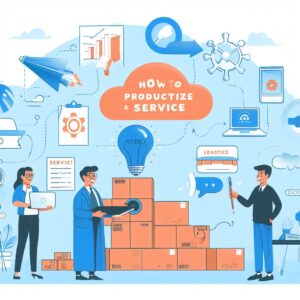
Documentation and Standardization
Develop thorough and accessible documentation, manuals, or guides that provide clear instructions on the steps, processes, and deliverables encompassed by your productized service. Streamline workflows to maintain consistency and coherence in all customer interactions.
Effective documentation plays a critical role in ensuring the smooth delivery of your productized service. It acts as a valuable resource for both your team and your customers, minimizing confusion and fostering a sense of trust and reliability. To create comprehensive documentation, start by identifying the key components, tasks, and processes involved in your service. Break them down into step-by-step instructions, providing detailed explanations, and including any necessary visual aids or examples.
Consider presenting the information in a user-friendly format, such as online manuals or downloadable guides. This makes it easily accessible to both your team members and customers, empowering them to navigate through the service effortlessly.
Standardization is equally important when it comes to optimizing customer interactions. It ensures that each engagement follows a consistent and coherent approach, regardless of the team member involved. By streamlining workflows and defining clear protocols, you establish a unified customer experience that reflects your brand values and professionalism.
To achieve standardization, identify the touchpoints where customers interact with your service. Examine each stage, identifying potential areas for improvement or standardization. Establish guidelines and best practices for responding to customer inquiries, addressing common concerns, and delivering consistent results. Provide ongoing training and support to ensure your team members are well-versed in these protocols and can deliver a seamless and uniform experience to your customers.
Regularly review and update your documentation and standardization processes to keep them relevant and up to date with any changes or improvements in your service. Encourage feedback from your team and customers to identify areas that require further clarification or refinement.
Investing in comprehensive documentation and standardization is crucial for the success of your productized service. By providing clear instructions, streamlining workflows, and maintaining consistency, you enhance customer satisfaction, minimize errors, and build a strong foundation for further growth.
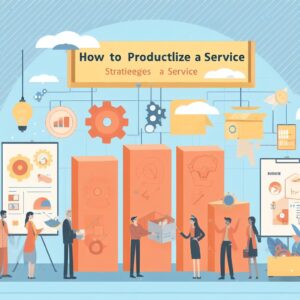
Technology Integration
Maximize the potential of suitable tools and technologies to automate and streamline processes, elevate the customer experience, and boost operational efficiency. Consider investing in customer relationship management (CRM) systems, project management software, or online platforms to ensure the effective delivery and management of your productized service.
In today’s fast-paced digital landscape, leveraging technology is vital to stay competitive and meet customer expectations. By strategically integrating appropriate tools and technologies into your operations, you can transform your service delivery, enhance customer satisfaction, and drive business growth.
Customer relationship management (CRM) systems are invaluable for managing and nurturing relationships with your customers. A CRM system enables you to store and organize customer data, track interactions, and gain valuable insights into customer preferences and behaviors. With this information at your fingertips, you can tailor your productized service to meet individual needs, personalize marketing efforts, and deliver a more engaging customer experience.
Investing in project management software empowers your team to collaborate effectively, optimize project timelines, and monitor progress. By centralizing communication, task assignment, and document sharing within a single platform, you can streamline workflows, improve coordination, and ensure timely delivery of your productized service.
Online platforms provide a convenient and accessible means to interact with customers and deliver your service. Whether it’s through a dedicated portal, a user-friendly website, or a mobile app, these platforms create seamless experiences for customers to access and engage with your productized service. They enable self-service options, facilitate transactions, and provide a consistent brand experience across different touchpoints.
When selecting technology solutions, consider your specific business needs, scalability requirements, and budgetary constraints. Conduct thorough research, seek recommendations, and evaluate potential options to ensure they align with your objectives and can integrate smoothly into your existing systems.
Moreover, stay informed about emerging technologies and trends relevant to your industry. Regularly assess your technology stack, keeping it up to date and agile to adapt to evolving customer expectations and market demands.
An embracing technology integration is essential for optimizing your productized service. By leveraging CRM systems, project management software, and online platforms, you can automate processes, enhance customer experiences, and drive operational efficiency. Stay proactive in exploring and adopting appropriate technologies to remain competitive in today’s dynamic business landscape.
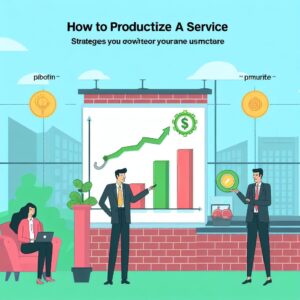
Marketing and Promotion
Craft a focused marketing strategy to effectively promote your productized service. Embrace diverse channels, including social media platforms, content marketing efforts, and targeted email campaigns, to reach and engage potential customers. Emphasize the distinctive value proposition and benefits of your offering to captivate attention and generate high-quality leads.
In today’s digital landscape, a well-executed marketing strategy is crucial to stand out amidst the noise and connect with your target audience. Leverage the power of various channels to effectively communicate your brand message and cultivate customer interest.
Social media platforms provide a dynamic avenue to engage with your audience, build brand awareness, and foster a sense of community. Develop a strategic social media marketing plan that showcases your productized service in an authentic and compelling manner. Share engaging content, leverage user-generated testimonials, and actively interact with followers to cultivate meaningful connections and establish trust.
Content marketing plays a pivotal role in educating, entertaining, and attracting potential customers. Create valuable, informative, and visually appealing content through blog posts, videos, infographics, or podcasts. By addressing customer pain points, demonstrating your expertise, and delivering actionable insights, you can position your productized service as a solution and build credibility within your industry.
Engage in targeted email campaigns to reach potential customers directly. Tailor your messaging to match different customer segments and stages of the buyer’s journey. Personalize emails, offer exclusive promotions or discounts, and use compelling calls-to-action to entice recipients to take action and convert into leads.
Highlight the unique value proposition and the benefits that set your productized service apart from competitors. Clearly communicate how your offering solves customer challenges, fulfills their needs, or enhances their lives. Use persuasive language, storytelling techniques, and compelling visuals to create an emotional connection and leave a lasting impression.
Regularly monitor and analyze the performance of your marketing efforts. Utilize analytics tools and metrics to gain insights into customer behavior, campaign effectiveness, and return on investment. Continuously refine and optimize your marketing strategy based on data-driven decisions, customer feedback, and industry trends.
A targeted marketing strategy is instrumental in successfully promoting your productized service. By leveraging diverse channels such as social media, content marketing, and targeted email campaigns, and effectively communicating your unique value proposition and benefits, you can captivate your target audience, generate quality leads, and drive business growth.
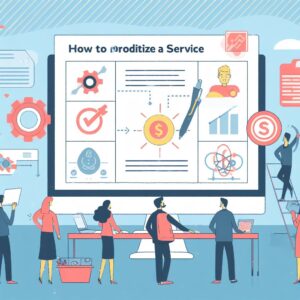
Feedback and Iteration
Foster an environment of continuous improvement by actively collecting feedback from customers and closely monitoring the performance of your productized service. Utilize customer insights and market trends to adapt, iterate, and optimize your offerings for sustained success. Regularly refine and enhance your solutions to stay ahead of the competition and effectively cater to evolving customer needs.
Feedback from customers serves as a valuable compass that guides your business towards improvement. Establish channels for customers to provide their input, such as surveys, reviews, or direct interactions. Actively seek out their opinions, suggestions, and pain points to gain a deep understanding of their experiences and expectations. Take this feedback seriously, appreciating it as an opportunity for growth and innovation.
Monitor the performance of your productized service by closely analyzing key metrics and gathering data on customer satisfaction, engagement, and retention. Leverage analytics tools to gain actionable insights into the effectiveness of your offerings and identify areas where enhancements can be made. Stay attuned to changing market trends, industry dynamics, and customer preferences to proactively adapt to evolving demands.
Based on customer insights and market trends, iterate and refine your productized service. Continuously incorporate customer feedback into your development processes, ensuring that your solutions align precisely with their needs and desires. Embrace an iterative mindset, making incremental changes and improvements to enhance the overall customer experience and deliver exceptional value.
To foster a competitive edge, regularly evaluate your offerings against those of your competitors. Stay abreast of industry innovations, emerging technologies, and customer expectations, and integrate relevant advancements into your productized service. By proactively evolving and surpassing customer expectations, you can position yourself as a market leader and differentiate your offerings from the competition.
Remember, feedback and iteration should be an ongoing cycle of improvement. Embrace a culture of continuous learning and adaptation, encouraging all members of your team to actively seek feedback, propose enhancements, and contribute to the evolutionary journey of your productized service. By consistently refining and enhancing your solution, you can ensure its long-term success and maintain customer satisfaction and loyalty.
By prioritize feedback and iteration as integral components of your business strategy. By proactively gathering customer feedback, monitoring performance metrics, leveraging market trends, and continuously refining your productized service, you can drive innovation and position your business for ongoing growth and success.

Conclusion
Productizing a service can unlock immense growth potential for service-based businesses. By transforming intangible services into tangible products, companies can enhance scalability, efficiency, and profitability. Remember to thoroughly understand your service and customers, define a clear value proposition, and implement effective strategies like decomposition, standardization, and technology integration. By following these best practices and continuously iterating based on customer feedback, you can successfully productize your service and stay ahead in today’s dynamic business landscape.
Remember, the process of productizing a service may vary based on your specific industry, target audience, and unique service offering. Adapt the strategies mentioned above to suit your business needs and goals.
